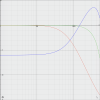- Joined
- Oct 10, 2020
- Messages
- 895
- Likes
- 2,895
I found this method very interesting so I decided to do a quick and dirty test of it with the tools I had on hand:

The black like is the summed response and we can see it is much smoother than either of the individual microphone responses - IMO showing that mode cancellation method works quite nicely. We also see the response doesn't contain the baffle step - which is as expected.
We also see the response doesn't contain the baffle step - which is as expected.
Note that responses arithmetically summed in REW don't contain harmonic distortion data of individual sweep measurements - which is something that a measurement done with the Mode Compensator would contain.
As a bonus, I also tried measuring with the first microphone ~15cm and the second ~30cm from the driver, this is what I got:

We see here the mode cancellation was less efficient this time, probably due to worse SNR at the increased distance from the driver.
Also, we see the shape of the response is different - IMO this is due to three reasons: 1) some baffle step may be present at this distance, 2) probably some of the port response is measured here as well (note that this is a front-ported speaker), and 3) comb filtering changes in frequency as we change the microphone distance (note that I'm not compensating for this in these measurements).
Hope this may be interesting to some!
- Neumann KH120A loudspeaker - I find this method especially interesting for loudspeaker with non-removable grills such as this one, where you can't really measure the LF driver in the ultra-nearfield (and therefore can't avoid some room influence with only one microphone)
- Cross-Spectrum Labs calibrated Dayton EMM-6 microphone (used as the closer "Measurement microphone")
- Rode NT2A in omni mode (used as the further "Mode microphone")
- REW with multi-input capture license
- The two microphones used to measure are significantly different in construction.
However their responses are reasonably close (+/-1dB) in the relevant range (40Hz-1kHz): - The sensitivity of the two microphones is slightly different - though I aligned the responses with preamp gain to within about 0,5dB
- The large body of the Rode NT2A will cause some undesired reflections in the higher midrange frequencies
- The distances between the two microphones (and microphone and driver) were only set approximately with a tape measure, similarly the angle of the microphone array axis to the driver was surely not exactly 90°
- Lastly I didn't apply the LP filter to remove the effect of the comb filter in the summed response
The black like is the summed response and we can see it is much smoother than either of the individual microphone responses - IMO showing that mode cancellation method works quite nicely.
Note that responses arithmetically summed in REW don't contain harmonic distortion data of individual sweep measurements - which is something that a measurement done with the Mode Compensator would contain.
As a bonus, I also tried measuring with the first microphone ~15cm and the second ~30cm from the driver, this is what I got:
We see here the mode cancellation was less efficient this time, probably due to worse SNR at the increased distance from the driver.
Also, we see the shape of the response is different - IMO this is due to three reasons: 1) some baffle step may be present at this distance, 2) probably some of the port response is measured here as well (note that this is a front-ported speaker), and 3) comb filtering changes in frequency as we change the microphone distance (note that I'm not compensating for this in these measurements).
Hope this may be interesting to some!





